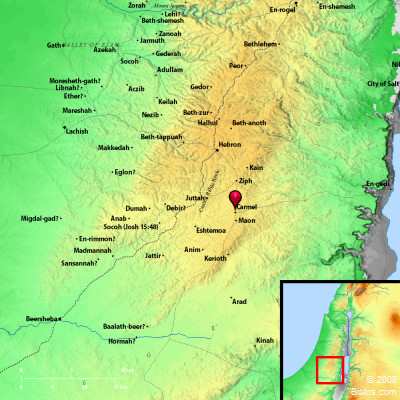Atlas  Gibeah 2 (Carmel) and surrounding region Maps Created using Biblemapper 3.0 Additional data from OpenBible.info You are free to use up to 50 Biblos coprighted maps (small or large) for your website or presentation. Please credit Biblos.com. Occurrences Joshua 15:57 Kain, Gibeah, and Timnah; ten cities with their villages.2 Chronicles 13:2 Three years reigned he in Jerusalem: and his mother's name was Micaiah the daughter of Uriel of Gibeah. There was war between Abijah and Jeroboam. Encyclopedia CARMEL(1) A beautifully wooded mountain range running for about 13 miles in a south-easterly direction from the promontory which drops on the shore of the Mediterranean near Haifa, at the southern extremity of the plain of Acre, to the height of el-Machraqah which overlooks the plain of Esdraelon. On the top of the promontory, at a height of 500 ft. the monastery of Elias stands. From this point there is a gradual ascent until the greatest height is reached at Esfiyeh (1,742 ft.), the peak at el-Machraqah being only some 55 ft. lower. The mountain-usually named with the article, "the Carmel"-still justifies its name, "the garden with fruit trees." The steep slopes on the North and East, indeed, afford little scope for cultivation, although trees and brushwood grow abundantly. But to the South and West the mountain falls away to the sea and the plain in a series of long, fertile valleys, where the "excellency" of Carmel finds full illustration today. There are a few springs of good water; but the main supply is furnished by the winter rains, which are caught and stored in great cisterns. The villages on the slopes have a look of prosperity not too often seen in Syria, the rich soil amply rewarding the toil of the husbandmen. Oak and pine, myrtle and honeysuckle, box and laurel flourish; the sheen of fruitful olives fills many a hollow; and in the time of flowers Carmel is beautiful in a garment of many colors. Evidences of the ancient husbandry which made it famous are found in the cisterns, and the oil and wine presses cut in the surface of the rock. There is probably a reference to the vine culture here in 2 Chronicles 26:10. In the figurative language of Scripture it appears as the symbol of beauty (Songs 7:5), of fruitfulness (Isaiah 35:2), of majesty (Jeremiah 46:18), of prosperous and happy life (Jeremiah 50:19). The languishing of Carmel betokens the vengeance of God upon the land (Nahum 1:4); and her decay, utter desolation (Amos 1:2 Isaiah 33:9). |



